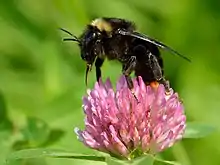| Bombus rupestris | |
|---|---|
 | |
| Male | |
 | |
| Female | |
| Scientific classification | |
| Domain: | Eukaryota |
| Kingdom: | Animalia |
| Phylum: | Arthropoda |
| Class: | Insecta |
| Order: | Hymenoptera |
| Family: | Apidae |
| Genus: | Bombus |
| Subgenus: | Psithyrus |
| Species: | B. rupestris |
| Binomial name | |
| Bombus rupestris (Fabricius, 1793) | |
| Synonyms | |
| |
Bombus rupestris is a species of cuckoo bumblebee present in most of Europe except Iceland. In the Balkans it is found in montane and alpine habitats northwards from Central Greece.[2][3] It is also found in Turkey.[3]
Description
The female is much larger than the male; she has a length of 20–25 mm (0.79–0.98 in), while the drone usually is not more than 16 mm (0.63 in).[4] The bumblebee is black, with the last abdominal segments coloured orange-red.[5]
Due to its parasitic lifestyle, no workers exist.
Behaviour
Bombus rupestris is found in flower-rich habitats, such as meadows and along hedgerows.[4] The bumblebee parasitizes the nests of the red-tailed bumblebee, B. lapidarius, whose queen is killed or subjugated.[5]
References
- ↑ "Bombus rupestris (Fabricius, 1793)". Biolib.cz. Retrieved 4 July 2012.
- ↑ Anagnostopoulos, Ioannis Th. (2009). "New records of bumble bees from the Northwestern mountainous region of Greece (Hymenoptera, Apidae)" (PDF). Entomofauna. 30: 445–449.
- 1 2 Discover Life. "Discover Life map of Bombus rupestris". Retrieved 28 February 2020.
- 1 2 Jim Lindsey (retired professor of Biostatistics). "Bombus rupestris". Archived from the original on March 13, 2008. Retrieved 28 February 2009.
- 1 2 Dr Brian Nelson, Ulster Museum. "Bombus (Psithyrus) rupestris – a cuckoo bumblebee". National Museums Northern Ireland. Retrieved 28 February 2009.
This article is issued from Wikipedia. The text is licensed under Creative Commons - Attribution - Sharealike. Additional terms may apply for the media files.